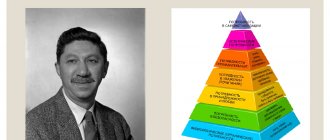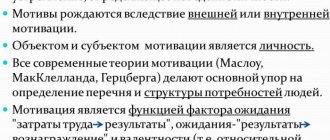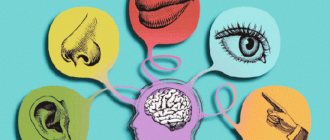The main role of associations in memorization is that we link new knowledge to information we already know. To build a good association, you need to know some useful criteria for finding connections between things, as well as develop your associative thinking and creative imagination. It is equally important to learn how to build associative series and connections to stimulate figurative memory.
This lesson will show you how to use the association method to remember information.
What are associations?
Association is a connection between individual facts, events, objects or phenomena reflected in a person’s mind and fixed in his memory. Associative perception and thinking of a person lead to the fact that the appearance of one element under certain conditions evokes the image of another associated with it.
The ability to make associations is the most important ability of our mind. There is even such a direction: associative psychology (or associationism), which tries to explain a person’s mental processes by studying his associations in connection with certain objects (stimulus - response); the process of memorizing information can also be considered from this point of view.
Use of association methods in psychodiagnostics
Associative connections can be used in psychodiagnostics to study human mental states. Scientists became interested in this problem at the dawn of psychology as a science. Thus, Sigmund Freud, one of the founders of the science of the unconscious, believed that the subconscious contains repressed desires and instincts of a person that contradict the demands of society. These repressed desires are driven into the “very corner of the brain,” but they do not disappear completely and continue to influence a person’s thinking and behavior. He develops certain phobias, he does strange things, he even develops mental and physical illnesses. Repressed desires, as Freud believed, can be identified using associative diagnostics.
Associative connections arise spontaneously and carry information about existing suppressed instincts and desires. Freud used the method of free association, which is still used today. The identified associative connections allow the specialist to make an accurate diagnosis.
This method is very simple, although it looks strange. The patient should sit comfortably, relax and talk about anything. At the same time, he speaks exclusively about what first comes to his mind.
Currently, some psychologists do not use free associative connections, but rather more organized and controlled ones by a specialist.
To identify associative connections, specialists analyze many aspects of the patient’s life. This is, for example, creativity. When a subject draws a scene, he will certainly use the associative connections that arise.
Of particular interest for study is associative thinking. It is often opposed to logical thinking, and there are certain reasons for this. This kind of thinking allows you to quickly connect information from different areas to solving a problem. This type of thinking acts as if bypassing logic. The solution to the problem in this case can be not only faster, but also deeper, and the approach to this solution can be non-standard.
Associative thinking can be developed, and in the modern world it is advisable to do this. Psychologists have developed many techniques for developing associative thinking skills.
This attention to this type of thinking is explained, in particular, by the fact that logical methods are relatively simple, and at the present stage of human development it is often necessary to solve more complex problems; In addition, logical thinking is increasingly becoming the prerogative of computers, and therefore people are moving on to solving issues where a machine is fundamentally unable to cope. However, researchers nowadays are trying to teach artificial intelligence associative thinking, and there have already been some successes in this direction.
Associative thinking is the area in which human individuality is most clearly manifested. Since most associative connections are of deeply “personal” origin. In our time, one might say, the very understanding of the essence of man is changing. If previously it was customary to hide and suppress personal experience in order to better comply with “social norms,” today it is the personal approach to various things that becomes more profitable. In the future, it is quite possible that a person in his activities will be guided mainly by associative thinking.
Types of associations
To find associations, there are several ways to build associative links between any objects:
- Contiguity in time or space: table and chair, winter and snow;
- Similarity (similarity): earth and ball, lamp and pear;
- Contrast (opposite): good and evil, black and white;
- Causal relationships: thunder and lightning, lamp and light;
- Generalization: tomato and vegetable, dog and animal;
- Submission: vegetable and cucumber, animal and cat;
- Subordination to one object: car and motorcycle;
- Part and whole: seconds and minutes, car and engine;
- Addition: toothpaste and toothbrush.
Depending on the application of these methods, as well as on various modifications and conditions of their use, different types of associations can be found. For example, associations are:
- thematic, in which objects are related to a single theme (marketing and advertising);
- phonetic, in which there is consonance between objects (lie and rye, night and daughter);
- word-forming, based on the unity of the root or other parts of the word (laziness and laziness).
It is worth noting that the associative processes occurring in our consciousness depend on the degree of participation of different sensory organs in them. Thus, visual, auditory, kinesthetic, gustatory and olfactory associations are distinguished. Depending on a person’s predisposition and the characteristics of his sensory representational system, it will be useful for him to build associations that are suitable specifically for him.
Some people have motor memory, like Napoleon (who wrote down each new name three times, threw away the note and remembered the name forever). Some people, due to their developed auditory memory, prefer to speak information out loud. The basis of memory for people tuned to visual perception (and these are the majority) is, for example, the purposeful highlighting of key words in the memorized text (underlining, coloring, creating diagrams and drawings).
With the development of memory techniques, people have already developed associative techniques that are suitable for most of us. These techniques are called mnemonics, and they will be discussed in one of the following lessons.
Main points
The term “associationism” was introduced in the 17th century by the English thinker Locke. The concept itself became widespread half a century later, although the method of representing the work of the brain using similar images was described by Aristotle and Plato. Representatives of associationism endowed this principle with the role of the leading or only mechanism for the activity and development of the human psyche and consciousness.
It is noteworthy that for Locke, the founder of the empirical study of the psyche, all the phenomena of mental activity he examined related to the individual experience of a particular person, that is, the scientist consciously excluded from his research the essence of the soul and its influence on the personality.
Are you ready to stop thinking about your problem and finally move on to real actions that will help you get rid of your problems once and for all? Then perhaps you will be interested in this article .
Locke considered association to be the key mechanism for the emergence of complex ideas. The associationist theory included any complex thoughts (decisions/ideas) that “are often combined in such a way that they cannot be separated later” as a combination of ideas that are incorrect, that is, not consistent with the natural existence of a person.
An example of an association according to Locke is:
- sympathy;
- superstitions;
- antipathies.
The philosopher introduced the term in a very limited way. This was followed by active development of this mechanism of consciousness, which resulted in the emergence of associative psychology.
Locke approved the following scheme for the emergence of ideas through association:
- Sensations in the process of development precede mental activity.
- Simple ideas are combined through associations into more complex ones.
- Experience becomes the basis of knowledge, the sources of experience are reflection and sensations.
- There are no innate associations.
The concept began to be actively used in pedagogy, and over time it was developed in personality psychology. The psychological school of associationism seeks to establish an exclusively causal study of individual behavior.
The direction is based on the thesis about the sequence of ideas that reflect the impact of external factors on a person.
Very strict postulates have been replaced by theories that originate from the ideas of Rousseau and assign a key role in the formation of personality to the internal features of human development.
By the beginning of the 19th century, the principles of associationism were formed:
- the concept of soul is something capable of knowledge;
- the psyche consists of the simplest elements - sensations;
- complex thoughts arise from associations from simple parts;
- all knowledge about the soul is the result of introspection. A person can only study his own world; the inner spiritual life of another person is not accessible to outsiders.
For associationism, each person is represented as a loner who lives in a community of loners. The inner world of the individual is opposed to the external environment, and there is a hard line between them.
Advances in science at the turn of the 19th and 20th centuries brought changes to the perception of the psyche by associationists. Some scientists have introduced additional aspects to the study of human mental activity.
Thus, Darwin changed the interpretation of the manifestation of emotions, Sechenov developed the doctrine of brain reflexes.
In modern psychology, associationism is considered an important movement in which a strictly causal approach is applied to the study of human behavior. Association becomes the main mechanism of psychological activity of the individual. Thinking comes down to combining several images in memory with associations (by contrast with the object, by similarity, etc.).
How to develop associative thinking?
Despite the fact that today there are many mnemonics that make it easier to build associations for memorizing various types of information, there is no universal technique that would be suitable for all cases. Often you have to create associations and systematize material for memorization on your own. Not everyone is good at associative memory, but it can be learned. Associative thinking is built, first of all, on our creative abilities, namely, on the ability to create something new by modifying what already exists.
The development of associative thinking is closely related to the imagination and a person’s ability to find similar elements even in the most different things, as well as to the training of figurative memory. On our website there is a special lesson on developing imagination in the course of creative thinking. You can familiarize yourself with this lesson by following the link.
In addition, expanding the range of associations can be achieved through targeted training. Below we offer you some simple exercises:
Exercises
Exercise 1. Solving doodles. Doodles are the invention of American humorist Roger Price and creative producer Leonard Stern. The essence of the invention is that you are asked to describe a picture that can have many interpretations. A droodle picture is something like a scribble, but in droodle the authors initially include variability in its perception. You can solve several droodles on this page.
Exercise 2. Drawing up a chain of associations. Choose any word and start building a chain of associations from it, writing them down on paper. For example, “trainings - courses - lessons - 4brain.ru”. Try to write down associations as quickly as possible, and make the connections as unusual as possible.
Exercise 3. Search for missing associations. Choose any two words or phrases that should have as little in common as possible. Try to build an association that connects these two words. For example, for the words “morning” and “food” the element complementing the associative series will be the word “breakfast”. Try to find the missing link for the words: film and dream, elevator and car, flower and skyscraper.
Exercise 4. Suitable associations. Choose two words and try to name associations that are suitable for each of these words at the same time. For example, for the words “white” and “light” one can name the following associations: snow, fluff, feather, etc. To complicate the exercise, you can choose not two, but three or even more words.
Exercise 5. Unusual associations. To develop associative thinking for the purpose of better memorization, it is useful to be able to look for the most striking and non-standard associations. In this case, the image will be better fixed in memory. Most people will give the following associations for these words and phrases:
- Russian poet - Pushkin
- Poultry - chicken
- Fruit - apple
- Part of the face - nose
Try to come up with other, less popular associations with the same words.
Statistics Full screen
Exercise 6. Drawing up mental maps. A useful exercise for developing associative memory is mental maps. One of the creators of the idea of compiling such maps, Tony Buzan, wrote in his book “Super Memory” that “... if you want to remember something new, you just need to relate it to some already known fact, calling on your imagination to help.” You can read more about the technique of drawing up mental maps consisting of associative series in the next lesson on memory development.
If you do at least some of these exercises for 10-15 minutes a day, then after a few days the workout will become easier and more exciting, and most importantly, you will be able to remember any new material faster.
Recommendations
To develop associative thinking in order to improve memorization of material, it is also useful to use the following recommendations. The associative connection should:
- arouse your genuine interest (how to achieve this was written in the previous lesson);
- touch various senses;
- be unusual, but meaningful to you;
- contain the most detailed picture (size, color, etc.).
And the main thing is that the association is bright and easy to remember.
So, the second rule of remembering:
To remember certain information well, find suitable vivid associations that will be an indispensable assistant in the process of representation (reproduction of information).











